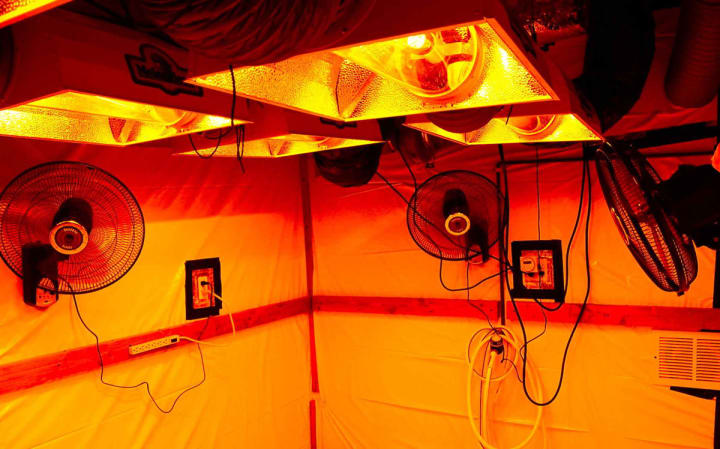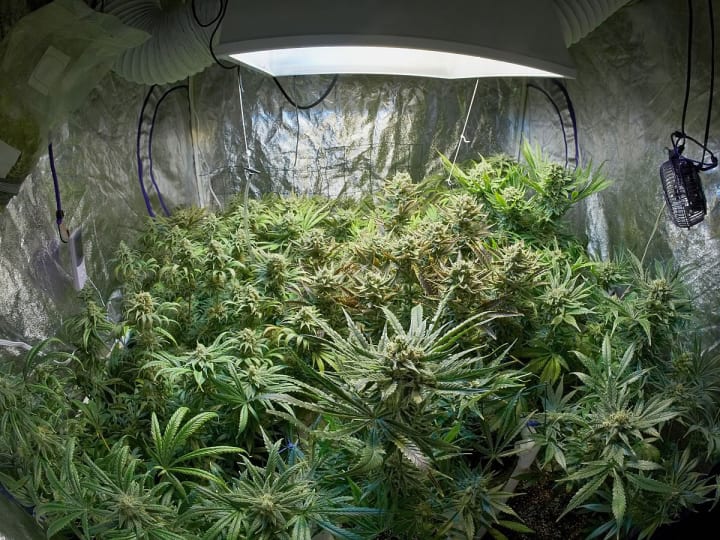
The main secret for growing outstanding marijuana indoors is a lot of light. With the 1,000 watt metal halide lamp and halide light grow bulb, it is hard to fail. Even average seeds, average soil, and a minimum amount of water and nutrients will give excellent results.
High Intensity Discharge lights have been used for many years in many commercial capacities such as street lamps and cars. There are several types of H.I.D. lights: mercury vapor, sodium vapor, and metal halide. We are only interested in 1,000 watt halide multivapor lamps. The best halide to choose for growing pot.
Types of Lamps

Image via HighTimes
The standard 1,000 watt metal halide light grow bulb needs a 1,000 watt metal halide fixture. It produces 100,000 lumens of light.
In the early 70s, Sylvania introduced what they call Sylvania “Super” metal halide. It fit the same fixture as a regular lamp, but it produces 125,000 lumens of light. It cost $4.00 or $5.00 or more, which was a lot for a lightbulb at the time, but it was worth it.
Another type of 1,000 watt halide light grow bulb created was the G.E. I-Line lamp, which worked in most mercury vapor fixtures. These were usually cheaper than metal halide fixtures and could often be found in junk yards or your city lighting department. On the mercury vapor fixture, you had to make sure it was marked (CW) constant wattage, minimum open circuit RMS voltage: 400.
Today, we believe the best buy is the iPower 1,000-Watt MH Grow Light Bulb with a standard metal halide ballast fixture. Many brands of lamps come in a clear or phospher coating, but we see no difference in growth or potency. Phospher increases the red, orange, and yellow spectrum.
All wavelengths are emitted by the metal halide light grow bulb and therefore all necessary colors are provided to your plants in great intensity. The resulting light of the lamp is white.
An important product of the light's function is heat. Metal halide lamps create the necessary tropical atmosphere, in addition to providing intense light. When you combine a hot environment with an abundance of light, the heat will act as a catalyst to growth.
Metal halide lamps can be ordered from most large lighting outlets, or online. Two other popular brand names for metal halide lamps are Plusrite and Sunlite. The optimum wattage is definitely 1,000 watts. You can plug a halide into a regular wall socket with a three-prong, grounded receptacle.
One 1,000 watt metal halide lamp of the standard, super, or I-Line form will provide you with two years of growing time, assuming that you use it about 16 hours a day. The fixture has a life of 10 years.
Under one light, you can grow as many as 20 plants in 13" by 12” pots or up to 50 plants in 10" pots.
There are two main styles of halide or mercury vapor fixtures: the single unit, where the ballast or transformer is attached to the hood of the lamp; and the remote unit, where the ballast is separate.
The separate units cost a bit more but are much easier to work with because you don't have to hang the heavy ballast. Also, this unit allows more maneuverability, since it can be raised 10" higher to the ceiling.
Electrical Guidance

Image via Big Buds Mag
The main thing when plugging in your 1,000 watt halide light is not to overload your circuit. Most home circuits are 20 amps. A 20 amp circuit is overloaded when there are more than 16 amps used. A 1,000 watt halide light grow bulb uses about 10 amps. Two halides on one 20 amp circuit are not considered safe.
It is very important to ground the fixture. If your house is not equipped with three-pronged, grounded receptacles, consult an electrician.
When placing the bulb into the socket, be sure to have the fixture disconnected from power. Tighten the bulb as far as it will go, but don't force it.
When using an automatic timer (recommended), make sure it can handle at least 1,000 watts.
If you ever need to use an extension cord, use a 12 gauge cord with a ground.
Finally, for maximum life of the lamp, always hang it within 15 degrees of hanging vertically.
The Growing Area

Image via Big Buds Mag
One 1,000 watt halide will light an area of 6' by 6'. If you paint the room bright white or use metal foil as a reflector, the area is increased to 10' by 10'.
The smaller the room and the more lights used, the more heat will be generated. If you end up with excess heat, an exhaust fan can be added to release the extra heat.
Lack of ventilation is a problem for indoor growers. Free moving air is necessary for quality growth. If fresh air is not available, plants grow slower and succumb to disease more easily. The more plants in a room the more important fresh air is. Water often, but don’t let the room become too humid. A temperature of about 80 degrees is optimum. The fan can be set to a thermostat to come on when the temperature gets too high.
Although 80 to 85 degrees are best for growing, just prior to your harvest, raise the temperature another 5 degrees or so to increase resin.
Photo Period

Image via Business Insider
Ideal photo period varies from strain to strain, but a general rule is to give most growing rooms 18 hours of light for the first three and a half months. Then shorten the “days” to 12 hours. Plants will start to bloom within five weeks after you drop the hours of light and will continue to bloom for two months or more. If your ceiling is 12' or higher, you can let your plants have 18 hours a day for five months.
Remember that every time you clip off branches or tops to increase leafage, you slow the blooming cycle by two or three weeks. Hormone concentration must rise again in order to produce flowering. We don't recommend 24 hour a day lighting because it produces too many male plants.
About the Creator
Ed Green
Gynecologist. Amateur Farmer and weed whacker. Loves figure skating and Liza Minnelli. Bakes amazing brownies.






Comments
There are no comments for this story
Be the first to respond and start the conversation.